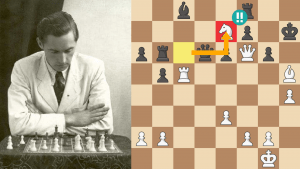
Noticing Change Or Opportunity On The Chessboard
At the beginning of a game the professional chess player understands the ins and outs of the opening he plays which, of course, has been deeply studied. He knows where his pieces should be, he is well-versed about the pawn structure’s needs, and he’ll know if it’s going to be a slow positional battle or a raw, vicious, tactical war.
Of course, if his opponent makes a mistake or somehow changes the position’s dynamics, then that slow positional battle might be tossed away and taken over by the hammer of Thor.
Naturally, the same thing can happen in the middlegame: you’re rolling smoothly down the river, you think you know exactly how the trip will go, and suddenly all hell breaks loose! And this takes us into the reality of tournament chess: Your game might well be quietly going along with your butterfly dreams, or a little tactic might rear its ugly head, or the board might be engulfed by a mushroom cloud.
Simply put, how can you notice change when it occurs? And how can you make use of opportunities if you’re not looking?

Sadly for amateurs, this is a catastrophic problem. In this new series I will give you puzzles that may or may not step off the yellow brick road. In either case, it’s up to you to figure out what’s going on, what’s best for the position, if an opportunity is screaming to be noticed, and (if you’re so inclined) you can even toss in some philosophical this and thats.
PUZZLE 1
Black has just played ...f7-f6 attacking White’s knight on e5. It can go to g4 or f3. Which one would you choose?
PUZZLE 2
This kind of position has been seen many times. Let’s look at three ways White can play: 14.Nxe4 trading some pieces, 14.Rb1 just in case that b-pawn will be attacked at some time, and the aggressive 14.g4.
Which one of these would you pick, and why?
PUZZLE 3
White has two popular moves: 6.cxd5, 6.h3, and 6.Bf4. Note that I gave three moves. Which one isn’t logical?
PUZZLE 4
White is threatening Black’s queen. How would you play this position as Black?
PUZZLE 5
White played 12.Ra3, intending to double rooks and put pressure on a7. Is this a very good move or did White have better things to do?
SOLUTIONS
ANSWER TO PUZZLE 1
Black has just played ...f7-f6 attacking White’s knight on e5. It can go to g4 or f3. Which one would you choose?
The reality here is that, by going to f3 or g4, White is bowing to Black’s dictates. Black psychically said, “I’m attacking your knight so you need to move it!” and White responded with, “Yes, I see that. Do you think I'm an idiot?”
I see this all the time! In fact, amateurs are often mesmerized when there’s a “he takes, I take back” situation. It’s part of the “I have to!” mentality (as in, “I have to take back!”). But in many cases, you do not have to take back.
In fact, White was winning in two ways:
AGAIN:
In Puzzle One, I said, “Where should you put your e5-knight?”
One gentleman said, “Puzzle 1 took me off guard.” Another said, “A more correct question is ‘what is White’s best move.’”
You missed the point. In a chess game you might see that your queen is attacked and your first thought is, “I have to save my queen!” However, a second look might tell you that you really don’t have to move the queen. In fact, moving the queen would be a mistake.
My asking where the e5-knight should move is a first thought. But DO NOT let first thoughts dictate what you will do.
In a nutshell: Nobody is going to tell you what is right or wrong during a chess game. There will be times when the obvious move is the best. But there will also be many times when the obvious is a loser. Don’t take anything for granted.
ANSWER TO PUZZLE 2
This kind of position has been seen many times. Let’s look at three ways White can play: 14.Nxe4 trading some pieces, 14.Rb1 just in case that b-pawn will be attacked at some time, and the aggressive 14.g4.
Which one of these would you pick, and why?
Overall, 14.Rb1 is passive. You’re not going to win games this way. 14.Nxe4 is best, when three results can occur. 14.g4 is a macho move that fails to notice a couple tactical patterns. First, the b-pawn is undefended. This would not be so bad if there weren't a second problem facing White. The second problem is x-ray tactics down the g1-a7 diagonal. Thus, if Black answered 14.g4 with 14...Qb6 you can confidently say that Black saw and used this opportunity.
ANSWER TO PUZZLE 3
White has two popular moves: 6.cxd5, 6.h3, and 6.Bf4. Note that I gave three moves. Which one isn’t logical?
The culprit is 6.h3. every move is important and you need to make sure the move you make is necessary. So, can you explain why 6.h3 was best? Indeed, does it do anything at all? Yes, it stops ...Bg4 or ...Ng4, but are those things to worry about? Not at all!
You can’t stop your opponent from moving his pieces and if you try, then you’ll find that you’re playing a purely defensive game. Simply put, 6.h3 is born from fear. Instead of trying to create a plan and push that agenda, you are quivering in fear over anything and everything. 6.h3 is the result.
It’s clear that 6.h3 doesn’t push any kind of agenda. Let’s look at the other two moves:
If you don’t like 6.cxd5, you can play:
ANSWER TO PUZZLE 4
White is threatening Black’s queen. How would you play this position as Black?
Beginners learn that bishops and knights are worth three points each, and that a rook is worth five. That is a very good thing to learn. However, as you get better and as you look at more and more master games, you’ll find that exchange sacrifices (giving up a rook for an enemy knight or bishop) are a dime a dozen. They are so common that you might start to challenge the old three points-vs-five points rule.
Of course a rook is better than a bishop or knight unless other details warp reality and kick the rules down the stairs. For example, if you sacrifice a rook for a powerful knight and pawn, you are only down a sad little pawn. And if you get that pawn and an attack, it really should be a no-brainer.
By now I would guess you’ve solved this little problem:
ANSWER TO PUZZLE 5
White played 12.Ra3, intending to double rooks and put pressure on a7. Is this a very good move or did White have better things to do?
White has the advantage, but 12.Ra3 is rather ponderous and allows Black to counter in the center (remember the old rule: “The best reaction to an attack on the wing is a counterattack in the center.”). Keep in mind that if you can play in the center you should usually do it (the center is the most important area of the board).
Nevertheless, White still has an edge after:
You might be saying, why is 12.Ra3 “ponderous” if it leads to an advantage for White? The problem is that White could have gotten quite a bit more by hitting the center right away:
In this game both sides were aware of the open a-file and putting pressure on a7. However, White failed to notice that the winds were blowing over the center. Part of this is that White didn’t ask (not verbally!), “What will Black do?” And, if you don’t know what your opponent should do then you are a walking target.






